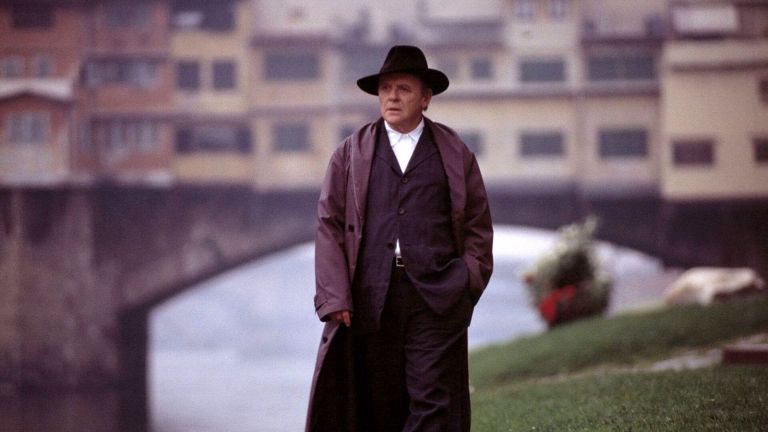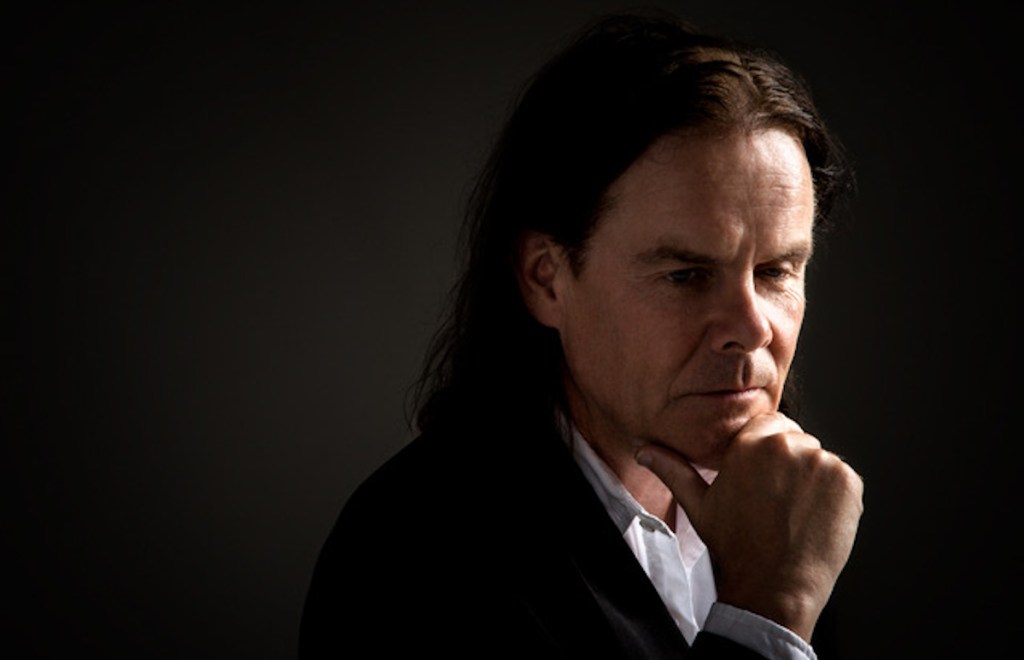How the Passion of Hannibal Lecter Inspired a New Opera About Dante
Twenty years after Hannibal, the movie’s most haunting piece of music, Patrick Cassidy’s “Vide Cor Meum,” has blossomed into a full-fledged opera about love, Hell, and Dante.

When you hear the name Dr. Hannibal Lecter, a few things spring to mind—and none of them are likely to involve Italian poet Dante Alighieri or opera. Of course there’s good reason for this, with Lecter’s exotic cooking ingredients superseding his gentler affectations. But even so, when author Thomas Harris first imagined how the character might move in the wild for the novel Hannibal, it was with baroque glee he unleashed the doctor in Florence: Italy’s Renaissance city and Dante’s medieval stomping grounds.
Director Ridley Scott similarly understood that secret recipe. His film version of Hannibal relishes every Italian colonnade Anthony Hopkins walks under, or the way the shadow of the statue of David casts darkness on its star’s face, often as he stands in the same spot where men were hanged or immolated centuries ago. In its better moments, Scott’s movie savors that this is a story about a devil who covets the divine; it delights in playing like an opera.
Hence for the picture’s best sequence, the filmmakers commissioned a new “mini-opera,” one that would for the first time put music to verses that Dante wrote more than 700 years ago. And in the decades since the movie’s release, those fleeting minutes of music have blossomed into a real, full-fledged opera about to have its world premiere. Once again the doctor’s distinct tastes and influences appear singular within the realm of movie monsters.
“He is a character that’s so exaggerated and extreme, I’m not sure if a person like Hannibal Lecter really could exist,” composer Patrick Cassidy says when we chat over Zoom, nearly 20 years to the day after Hannibal’s release. “He’s a great figure for drama because he is all of these extremes.”
Cassidy should know. Once a young Irish composer who was a relatively new member of Hans Zimmer’s large Remote Control Productions film scoring company, Cassidy’s sumptuous Italian aria “Vide Cor Meum” elevated Lecter’s Italian sojourn on screen, and placed its composer on the path to eventually becoming a Cavaliere dell’Ordine della Stella d’Italia (Knight of the Star of Italy). That’s all the more remarkable since Cassidy didn’t even speak Italian when he first set a Dante sonnet to music.
Looking back now, Cassidy remarks, “I was working with Hans Zimmer at the time, who was the composer on the movie. He works on a lot of projects simultaneously and he knew my strength was choral music… They needed an aria and they were shooting the scene in two weeks. So I was in the right place at the right time.”
The sudden impetus for needing an original aria in the movie seems to hail from Scott. In Harris’ novel, a similar scene occurs when Dr. Lecter attends the performance of a real symphony written in the 19th century, but for the movie Scott, Zimmer, and producers Dino and Martha De Laurentiis wanted something original: an aria based on a Dante poem which Hannibal repeats several times throughout the book and film. Written in 1283 when Dante was just 18, the poet’s first sonnet in La Vita Nuova is a paean to Beatrice, the woman he loved. Within its verse, the sonnet includes the following:
Joyfully Amor seemed to me to hold
my heart in his hand, and held in his arms
my lady wrapped in a cloth sleeping.
Then he woke her, and that burning heart
he fed to her reverently, she fearing,
Afterwards he went not to be seen weeping.
– Dante’s First Sonnet
Says Cassidy, “[The aria] had to be based on the first sonnet in La Vita Nuova because that sonnet has a metaphor about eating the heart. But of course Hannibal might have taken that in a literal sense.” Indeed, on both the page and screen, storytellers wanted Hannibal to pivot around the uneasy idea of the debonair cannibal giving his heart to Clarice Starling. After all, “Vide Cor Meum” is Latin for “Look into My Heart.”
Cassidy, however, had little time to digest these finer details when the opportunity to write the aria arose. Relatively new to Hollywood after being in Los Angeles only a year—and succeeding as a choral composer in his native Ireland with Children of Lir, the first major symphonic work in the Irish language—he was primarily tasked with working on library music at Zimmer’s company when the assignment came down: They needed “a good aria” ASAP.
“There was no room for anything to go wrong in a sense,” Cassidy says. “Ridley was already in Florence shooting the movie, but Ridley’s editor Pietro Scalia came into my studio and he brought in lots of CDs of Italian arias, being Italian himself.” This proved particularly useful because while the composer speaks Italian today, he needed to rely on Scalia’s ear while putting Dante’s words to music then.
Cassidy adds, “Ridley also sent me some sketches, which are very fantastic sketches of what the opera would look like. Of course then there was also Dante’s poem. So we started from that, and I think Pietro came back two days later and while I didn’t have the full aria written, I had a nice thematic kind of sense at that stage.”
By his own account, Cassidy estimates he wrote the full aria in under a week.
As a piece of choral composition, “Vide Cor Meum” is transcendently beautiful. Reliant on choral harmonies and luscious strings, the piece more than recites fragments of Dante; it taps into a sense of revelry and underlying melancholy—bringing out the inherent musicality in Dante’s lamentations. This is crucial to both the sonnet and the music’s effect, since the original verse was written in a style of poetry later dubbed by Dante to be the “dolce stil novo” (sweet new style) due to its idealization of Beatrice. This level of worshipfulness was significant for the author since the woman he adored died at the age of 25, four years before La Vita Nuova was released in 1294, complete with new prose around the sonnets in which Dante grapples with her death.
“Vide Cor Meum” brings those aspects out so hauntingly that it’s demanded greater attention ever since its inception. Even back in 2000, the piece was originally only meant to exist in its one minute of screen time; yet it was expanded to two and a half minutes at the request of Scott and the De Laurentiis’ after they heard that minute of music. And once the film was complete, Cassidy was then asked to turn it into a full aria of more than four minutes, or “mini-opera,” on the soundtrack.
Says Cassidy, “Everybody loved the aria instantly, and it was kind of immediate, really, for all the people involved, including Martha and Dino. Ridley especially loved it, and they were all thinking, ‘Maybe you should write a full opera?’ But then nobody knew what the opera should be about.” Editor Scalia did offer an amusing suggestion: write a full-length Italian opera about Hannibal Lecter.
It’s probably for the best that the Hannibal the Cannibal opera never happened, and as the years passed, everyone, including Cassidy, moved onto other projects. Still, the legacy of “Vide Cor Meum” continued to grow. In 2007, listeners of the UK’s Classic FM ranked the Hannibal score in the top 100 film soundtracks of all time (likely in large part due to “Vide Cor Meum”), and the piece has appeared in numerous other places, including another Ridley Scott film, Kingdom of Heaven.
“I loved it in that movie,” Cassidy says, “I thought that was an incredible scene. In many respects I even nearly prefer it in that movie than I do Hannibal.” And as the aria endured, so too did the persistent idea of expanding on it… and on Dante.
In 2010, producer Dino De Laurentiis passed away. While Cassidy had lost touch with the De Laurentiis family over the years, they obviously left a mark on each other, with Cassidy’s career rising after “Vide Cor Meum,” and Dino accepting his Irving G. Thalberg award from the Academy in 2001 to an orchestration of the aria—a development Cassidy suspects Dino’s wife had a hand in.
“Martha loves the piece, so I think she probably organized that,” Cassidy says. “When Dino passed away, I went to the funeral and I was going to pay my condolences to Martha, and there were rows and rows of people around her. But she saw me in the back and she said, ‘Hey, Patrick where’s Dino’s opera?!’”
It’s visibly a sweet memory for Cassidy, even as he recalls he didn’t tell Martha at the time he’d already begun work on expanding what was originally just a two-minute composition into an opera, one with a specific subject matter: Dante Alighieri.

Cassidy says, “Maybe two or three years later, I called her into my studio to give her a presentation of what I’d done on the opera and she loved it, and she wanted to be the producer immediately.” He was also able to show why the opera could only ever be about Dante, the medieval writer who similarly electrified the imaginations of Thomas Harris and his most famous fictional character.
“I think Dante was transitioning out of the Middle Ages into the Renaissance,” Cassidy says about the poet. “Especially in La Vita Nuova, the poetry is in the troubadour tradition of the idea of chivalric love. So it’s kind of a foreign idea to us. When we think of love [it’s] not as an idealization, but just a passion in a sense… for him [love] was quite religious, and he often associates Beatrice with the Virgin Mary.” That sense of an almost deification of love—Amor is a godlike character in La Vita Nuova—also gave Cassidy the space to build a story out of Dante’s life, as opposed to just adapting his most famous and macabre work, La Divina Commedia (The Divine Comedy).
“I realized the mistake would have been to do an opera about La Divinia Comedia where you had the Inferno, Purgatorio, Paradisio,” says Cassidy. “What I did instead was [make] the opening scene in the opera be the first meeting of Beatrice and Dante when they’re both 12 years of age. And then the opera finishes when Dante, at the end of Paradisio, meets Beatrice again in the heavenly paradise, which is the Garden of Eden. So that was the core of the story, it’s a love story of Dante in pursuit of Beatrice.”
It’s a shrewd choice since many forget that at the end of La Vita Nuova, Dante concludes by saying he will write an epic poem unlike any other, and it will be dedicated to Beatrice. Nearly 30 years later, and about 12 months before Dante’s own death in 1321, The Divine Comedy was published with its most famous passages about Dante descending down through the nine circles of Hell. However, it also features Dante ascending to the heavens where he finds Beatrice as his guide to Paradise. When these elements are combined, you have the stuff of opera.
“The second act is Inferno,” Cassidy says, “And at the beginning [of the act], Dante meets Virgil, and Virgil explains that he has been sent by Beatrice to guide him through the underworld.” In the pits of Hell, “Vide Cor Meum” will even have a reprise. While the aria appears much as it did in Hannibal during the first act of Cassidy’s opera, it’s then sung a second time in act two when a siren in the Inferno attempts to seduce Dante, and Beatrice’s angelic voice intercedes.
It’s an ambitious concept, and one Cassidy has been working toward on and off for six years. The composer’s Dante was supposed to have its world premiere later this year in Verona—in time for the 700th anniversary of Dante’s death in 1321. Unfortunately, like many other plans since 2020, whether Dante meets that anniversary is currently up in the air.
“We were hoping to premiere it in the anniversary year,” Cassidy says, “but I don’t know what’s going to happen.” Fortunately, the Irish composer can stay busy. With Dante finished, Cassidy is already working on his second opera, this one with the added challenge of being in English: King Arthur.
“After writing a whole opera in Italian, [you realize] it’s the best language for music. I mean, you really can’t go wrong because it just sounds so beautiful… writing a new opera in English, it’s more difficult. It’s more difficult to make work.” Although as with Dante, King Arthur provides Cassidy with the chance to explore medieval classics, specifically Sir Thomas Malory’s famed 15th century tellings of the King Arthur legend.
Cassidy also recently released a new recording of “Vide Cor Meum” on Apple Music and Spotify, one of two pieces he now has in “A-List Classical” on Apple after another of his works, “The Proclamation,” gained international attention when it was used by President Joe Biden during his Presidential Inauguration Mass. But Cassidy does remain hopeful that Dante will still have its day this year, in Verona or otherwise.
“I would hope that even if we don’t get a full production that we will get something done on Dante this year, because it is an anniversary,” Cassidy says.
Whenever it does debut, Dante and its most famous aria will have come a long way from their origins in a horror movie. But in a certain sense, one imagines Dr. Lecter would approve.


